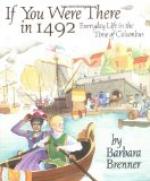Cardinal ALIACO’S “Cosmographia.”
But of all the works of learned men, that which, according to Ferdinand Columbus, had most weight with his father, was the “Cosmographia” of Cardinal Aliaco. And this book affords a good illustration of the then state of scientific knowledge. Learned arguments are interspersed with the most absurd fables of lion-bodied men and dog-faced women; grave, and sometimes tolerably sound, disquisitions on the earth’s surface are mixed up with the wildest stories of monsters and salamanders, of giants and pigmies. It is here that we find the original of our modern acquaintance, the sea-serpent, described as being “of huge size, so that he kills and devours large stags, and is able to cross the ocean;” and the wonders of the unknown world are enunciated with a circumstantial minuteness which must have easily won the credence of a willing disciple like Columbus. He was also confirmed in his views of the existence of a western passage to the Indies by Paulo Toscanelli, the Florentine philosopher, to whom much credit is due for the encouragement he afforded to the enterprise. That the notices, however, of western lands were not such as to have much weight with other men is sufficiently proved by the difficulty which Columbus had in contending with adverse geographers and men of science in general, of whom, he says, he never was able to convince any one. After a new world had been discovered, many scattered indications were then found to have foreshown it. “When he promised a new hemisphere,” writes Voltaire, “people maintained that it could not exist, and when he had discovered it, that it had been known a long time.” It was to confute such detractors that he resorted to the well known expedient for making an egg stand on end; an illustration of the meaning of originality which, by the way, was not itself original, as Brunelleschi had already employed it when his merit in devising a plan for raising the cupola of Florence cathedral was questioned.
Evidences of A western world.
Of the amount of evidence furnished by the testimony of sailors, it is difficult to speak with any degree of accuracy. Rumours of drift-wood, apparently carved with some savage implements; of mammoth reeds, corresponding with Ptolemy’s account of those indigenous to India; even of two corpses, cast up on one of the Azores, and presenting an appearance quite unlike that of any race of Europe or Africa; all seem to have come to the willing ears of Columbus, and to have been regarded by him as “confirmations, strong as proofs of holy writ,” of the great theory.




